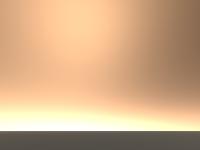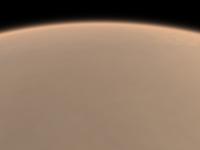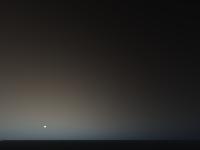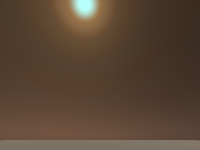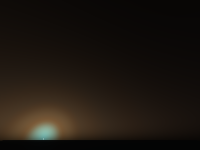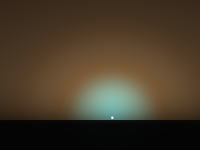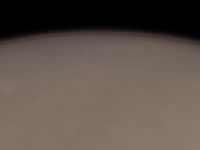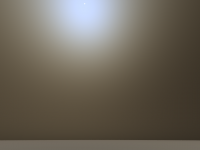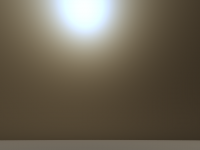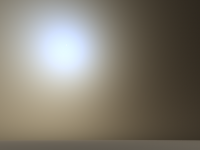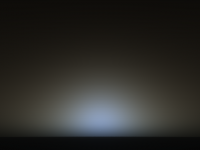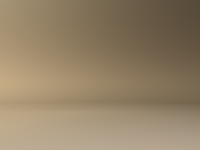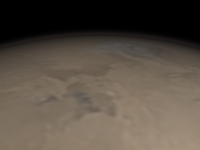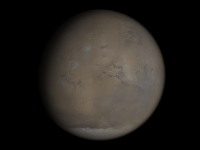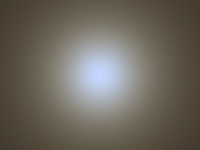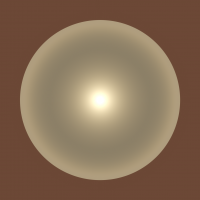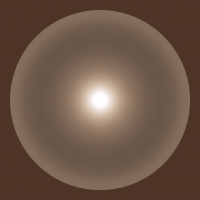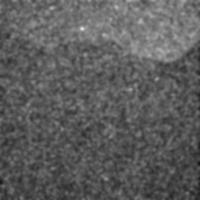Printable Version of Topic
Click here to view this topic in its original format
Unmanned Spaceflight.com _ Mars _ The Martian Sky
Posted by: Bjorn Jonsson Oct 11 2009, 06:41 PM
I have been attempting to make computer generated images of the Martian atmosphere, both as seen from the surface and from space. To check the results I have been looking for spacecraft images to use as ground truth. I have found lots of images - by far the best ones I have found are from UMSF in this thread: http://www.unmannedspaceflight.com/index.php?showtopic=3324
However, I'm always looking for more ;-). So if anyone knows of more and/or better images I'm interested in them. What would be best are mosaics showing the sky from the horizon (with the horizon/surface visible) and towards the zenith.
The sky varies a lot because of variable amount of dust but the general impression I get is that the sky is bright near the horizon (usually brighter than the surface) but gets much darker higher in the sky. There is probably a fairly large, bright area in the sky near the sun, possibly less reddish (lower R/B ratio) than parts of the sky farther from the sun.
I'm already getting fairly interesting results, this one has a field of view of 90 degrees:
(needless to say this one is 'overexposed' near the horizon; dynamic range is sometimes a problem)
The problem is that even though this may not be bad the limb currently appears far too bright as seen from space :
This shows that my atmospheric model is erroneous in some way - I suspect that as seen from the surface the Martian sky is darker high above the horizon than I have been assuming.
Posted by: djellison Oct 11 2009, 07:29 PM
That first image is surprisingly (and pleasingly) similar to what Dreamscape ( a terrain and sky plugin for 3ds max) produces when I'm rendering my HiRISE DEM flyovers.
Posted by: ngunn Oct 11 2009, 09:24 PM
I expect you've seen this paper (one of my favourite ones), but just in case not:
http://marswatch.astro.cornell.edu/Bell_etal_SkyColor_06.pdf
Posted by: Ant103 Oct 13 2009, 08:42 AM
The first image seems very good for me. Don't know if you know, but with Terragen you can made very good sky, with various parameters like intensity of atmospheric scattering, or dust opacity (and color).
Don't know if it's accurate but I like make "artificial" skies like here :
http://www.astrosurf.com/merimages/Phoenix/2008/JamesCanvin-peter_pan-ArtificialFullSky-V2-medres.jpg
http://www.astrosurf.com/merimages/Desktop/HomePlate-desktop.jpg
You can also have a look on this galery of picture from Olivier : http://www.planete-mars.com/goursac/2006/vision2.html
Posted by: mcaplinger Oct 13 2009, 04:48 PM
According to Mark Lemmon -- http://www.unmannedspaceflight.com/index.php?act=findpost&hl=&pid=9656 -- for typical dust loadings the brightness variation from horizon to zenith is no more than a factor of two and wouldn't be very visible to the naked eye.
Posted by: djellison Oct 13 2009, 05:15 PM
I've dabbled with Terragen, but not much. It would save a LOT of rendering time to pre-render a nice sky like that in Terragen, then map that to a sky hemisphere in 3ds max rather than using Dreamscape. Do you have a save file for that Terragen render as a starting point (or a list of parameters)
Posted by: Bjorn Jonsson Oct 14 2009, 12:49 AM
Thanks - the paper mentioned by Mark Lemmon turned out to be extremely useful. Seems I might end up using a more sophisticated atmospheric model than I'm currently using. For the dust I'm currently using Mie scattering only and have been experimenting with varying the amount of scattering, optical depth and adjusting a parameter similar to the Henyey-Greenstein asymmetry parameter. This has been largely a process of trial and error.
I still suspect the relative brightness of different parts of the sky varies a lot depending on atmospheric conditions and the sun's position in the sky. For example the brightness near the horizon can be highly variable:
http://photojournal.jpl.nasa.gov/catalog/PIA06915
There are many more similar examples, including images/mosaics from the pancam (this one is from the navcam). In this one the brightness of the sky varies by a factor of more than three. Here is another one, this time from the pancam. It was taken over a period of 8 days which might mess things up a bit:
http://photojournal.jpl.nasa.gov/catalog/PIA07334
Then there are these images where the sky darkens a lot when you get higher above from the horizon:
http://photojournal.jpl.nasa.gov/catalog/PIA06765 and
http://photojournal.jpl.nasa.gov/catalog/PIA06850
I suspect the sun was fairly low in the sky which probably contributes to this effect.
Another aspect of the Martian sky: Interestingly the sky is bluish near the sun, at least when the sun sets:
http://photojournal.jpl.nasa.gov/catalog/PIA07997
I'm fairly happy with the sunsets I'm getting from my renderer, especially because I should be able to improve it significantly:
Far from perfect but not too bad. As these are experimental images they are rather crude to speed things up (for example no antialiasing). The parameters I'm using now are different from the ones I used for the images in the first message of this thread. For example I decreased the scattering and increased the optical depth.
Posted by: vikingmars Oct 14 2009, 10:43 PM
![]() ...And here is a photo controlled mosaic showing the Martian Sky at VL2 site... with quite accurate color.
...And here is a photo controlled mosaic showing the Martian Sky at VL2 site... with quite accurate color.
Enjoy also ! ![]()
Posted by: mwolff Oct 15 2009, 03:32 PM
I still suspect the relative brightness of different parts of the sky varies a lot depending on atmospheric conditions and the sun's position in the sky. For example the brightness near the horizon can be highly variable:
[...snip...]
As you suggest, the phase function (or scattering angle) and optical depth, are the primary variables in explaining the array of sky brightness profiles in your list of example images. As such, the assumed form of the aerosol phase function will be very important in reproducing observations. Simple functions like the Henyey-Greenstein are notoriously poor for the particle sizes and wavelengths involved here, particularly if the range of photometric angles sampled in an image (or mosaic of images) is large. Recent analyses using MEX/OMEGA and MRO/CRISM have substantially improved aerosol scattering properties in the Pancam filter range such that you should be able to reduce the number of ad hoc parameters in your rendering. At a first approximation, the shape of the Tomasko et al. (1999) phase functions does quite a nice job...and avoid the inevitable backscatter enhancement that simple analytical (nonspherical) shapes can produce, such as the D/L=1 cylinders that i typically use. Of course, one can empirically remove this enhancement without much effort...and easily capture the behavior seen in the Tomasko et al. work.
I am curious about the level of radiative transfer that you are using in your sunset images...they look quite nice.
Posted by: djellison Oct 15 2009, 10:12 PM
All those words and 'sky hemisphere' didn't get mentioned once. Good work Mike.![]()
Posted by: ngunn Oct 15 2009, 10:39 PM
Sorry - who's Mike? - and who mentioned 'sky hemisphere'? I'm beginning to feel like a cat in a shoe factory. What is going on?
I'm extremely interested in the colour of the Martian sky but I can't make head nor tail of this. Please be a little more explicit.
Posted by: djellison Oct 16 2009, 05:59 AM
Check the bottom of http://pancam.astro.cornell.edu/pancam_instrument/team.html
The Sky Hemisphere is the unlikely-to-ever-happen idea of doing a full pan of the sky, with Pancam.
Posted by: ngunn Oct 16 2009, 07:38 AM
Much appreciated, thanks Doug. I'll start agitating for a sky hemisphere now. ![]()
Posted by: DDAVIS Oct 16 2009, 07:53 PM
I wish they would place a hemispherical mirror somewhere on Martian lander/rover spacecraft within camera sight, over somewhere on the spacecraft that would be blocking the scene anyway. it should be large and close enough to provide a mini fisheye view of the sky to the camera, providing at a glance (at least early in the mission) a visual summary of brightness variations, clouds, halos, etc.
Posted by: Ant103 Oct 16 2009, 08:26 PM
Humů I will better prefer a camera with a fisheye lens like "8mm fisheye pelang" pointed toward zenith, with a color CCD, somewhere on the deck of the lander/rover.
Posted by: DDAVIS Oct 16 2009, 11:01 PM
So would I, but the mirror should be easier to arrange in the competition for room etc.
Posted by: djellison Oct 17 2009, 08:41 AM
It would also be a lot lighter. Beagle 2 used a wide angle mirror that would pop up infront of its camera to get a complete 360 very quickly and dirtily.
Posted by: Ant103 Oct 17 2009, 11:32 AM
Here is the settings of the atmosphere in TG2, sets by default to have a classical blue sky. Maybe you can give me some advise to have a martian sky.
And the settings to hava "martian sky", with the result rendering (notice that the fov is 104░ with a sun at 45░ high in the sky).
Posted by: Bjorn Jonsson Oct 19 2009, 12:58 AM
I assume "exp height" is the scale height. If that is the case it is incorrect - it should be ~11 km for both haze (dust) and bluesky.
Thanks to everyone for useful information - mwolff's message was especially helpful. As I was starting to suspect, using a Henyey-Greenstein (or similar) phase function didn't work well (before seeing mwolff's message I was even considering using the sum of two or more HG-functions). I was able to get nice sunset images but in that case images with the sun high in the sky looked bad or vice versa. So I replaced it with the Tomasko et al. functions (444 nm and 671 nm) mentioned by mwolff. Actually I simply measured the function values from a graph in the Tomasko et al. paper and construced a lookup table. The function isn't perfectly smooth yet - this shows up in some of the images where the sun is visible. Dynamic range is a big problem so I processed the function in Excel to greatly reduce its dynamic range while preserving the color ratio (R/B) as a function of scattering angle. The results are very promising. I still need to do some tweaks, for example I probably need to increase the optical depth (the normal optical depth is currently ~0.18) and I'm currently assuming it doesn't vary with wavelength which I'm not sure is correct.
Some test images:
The sun as seen from the surface, the field of view (FOV) is 90 degrees. Interestingly, the sky near the sun has a bright bluish color. I don't know how accurate this is:
Similar viewing geometry but looking in roughly the opposite direction:
Sunset, the upper one has a FOV of 90 degrees and the lower one a FOV of 30 degrees. From these images I suspect I need to change some parameters because if I slightly increase the solar elevation a large area around the sun gets completely saturated. Because this didn't happen with the sun high in the sky (see above) I suspect the amount of inscattering is too high relative to absorption. From a comparison with actual images from the surface I suspect the sky is also too bright near the sun here which also implies I need to increase the optical depth (i.e. absorption).
Flying above the surface, altitude 7 km (upper one) and 607 km (lower one). FOV 40 degrees:
As previously, these are rather crude test images without antialiasing. Also to speed things up I'm using a low resolution texture map and no DEM.
I might eventually make my renderer available one day - this has been a very helpful discussion. However, a lot of work remains before that's even possible.
Posted by: vikingmars Oct 20 2009, 07:47 AM
Bjorn, your test images and simulations are really interesting ![]()
Here are 2 color samples to show the color of the Martian sky (close to the horizon + at zenith) that is considered to be the closest to the "moderate yellowish brown" (although it's not looking so "yellowish brown" close to the horizon) as seen by the VL landers and confirmed later by MPF and MER. It's the average color, useful for computing, that is NOT taking into consideration the dust opacity variations over the Martian seasons. Enjoy ![]()


Posted by: mwolff Oct 20 2009, 04:53 PM
I suspect the amount of inscattering is too high relative to absorption. From a comparison with actual images from the surface I suspect the sky is also too bright near the sun here which also implies I need to increase the optical depth (i.e. absorption).
[...snip...]
I would be interested in whether realistic forward scattering properties (i.e., derived from CRISM EPF sequences) would help. In the tabulation below, you can directly apply the single scattering albedo (Csca/Cext) and the wavelength dependence of the extinction (normalize Cext to your favorite wavelength, say 0.88 or 0.90 microns to scale MER Pancam optical depths). The model below assumes one is interested in an effective particle size (r_{eff}) of 1.5 microns (v_{eff} = 0.3).
wave = wavelength in micrometers
Cext = extinction cross section (arbitrary units)
Csca = scattering cross section (same units as Cext)
kappa = ignore
g = asymmetry parameter
wave Cext Csca kappa g
0.4400 4.4040e+00 3.4910e+00 1.8460e+16 7.6870e-01
0.4600 4.4230e+00 3.5760e+00 1.8540e+16 7.6200e-01
0.4800 4.4360e+00 3.6780e+00 1.8600e+16 7.4980e-01
0.5000 4.4660e+00 3.7980e+00 1.8720e+16 7.4040e-01
0.5250 4.4680e+00 3.9270e+00 1.8730e+16 7.2790e-01
0.5500 4.5060e+00 4.0800e+00 1.8890e+16 7.1330e-01
0.5750 4.5150e+00 4.2010e+00 1.8930e+16 7.0650e-01
0.6000 4.5420e+00 4.3260e+00 1.9040e+16 6.9290e-01
0.6300 4.5830e+00 4.4250e+00 1.9210e+16 6.8760e-01
0.7000 4.6190e+00 4.5100e+00 1.9360e+16 6.8060e-01
0.7500 4.6630e+00 4.5580e+00 1.9540e+16 6.7820e-01
0.8000 4.7110e+00 4.6030e+00 1.9750e+16 6.7700e-01
0.8500 4.7480e+00 4.6350e+00 1.9900e+16 6.7730e-01
0.9000 4.7700e+00 4.6510e+00 1.9990e+16 6.7870e-01
0.9500 4.7850e+00 4.6640e+00 2.0060e+16 6.7990e-01
1.0000 4.8350e+00 4.6940e+00 2.0270e+16 6.7920e-01
Posted by: tolis Oct 21 2009, 01:09 PM
One question that is relevant to the appearance of the Martian sky is whether one would expect to see stars during the daytime.
My impression is that the answer to this question would be heavily dependent on the amount of dust in the atmosphere.
Perhaps the more technically-oriented members of this forum can help..
Regards to All,
Tolis.
Posted by: vikingmars Oct 21 2009, 01:37 PM
Unfortunately, NO stars are visible during daytime : this fact was confirmed after the VL1 landing in 1976, because the dust makes the sky too bright for stars to be visible even at zenith.
Maybe the only place where the brightest stars (and planets) could be visible from the ground on Mars AND only when dust opacity is at its lowest, is at the summit of the highest volcanoes... But to see them you would have to concentrate your vision a bit, avoiding ambiant sunlight, staying in the shadow of a big rock for example, as the Apollo astronauts did on the Moon by looking at the brightest stars from the shadow of the LM...
Posted by: Bjorn Jonsson Oct 21 2009, 05:39 PM
[Snip]
Thanks - I'll try this and see what happens. Might take some time though.
Meanwhile, I've been having a look at some more images. This one is particularly interesting because of the caption:
http://photojournal.jpl.nasa.gov/catalog/PIA00917
The image caption says:
This is interesting because I was not sure the bluish color near the sun when it is high in the sky in my images is correct. However, according to the Tomasko et al. phase function much more blue light than red gets scattered at low scattering angles and I have been having problems 'suppressing' the bluish color with the sun high in the sky without losing that color at sunset too (I might be able to fix this using data from mwolff's table though). Does anyone know of true color images showing the Martian sky relatively near the sun and with the sun high in the sky? I haven't found any that I'm happy with.
Maybe the only place where the brightest stars (and planets) could be visible from the ground on Mars AND only when dust opacity is at its lowest, is at the summit of the highest volcanoes... But to see them you would have to concentrate your vision a bit, avoiding ambiant sunlight, staying in the shadow of a big rock for example, as the Apollo astronauts did on the Moon by looking at the brightest stars from the shadow of the LM...
And the 'star' easiest to see might be the Earth...
Posted by: Bjorn Jonsson Dec 1 2009, 12:33 AM
I have now made significant improvements to my rendering software. It's about 6 times faster now, meaning I can do nice animations without keeping my computer running for something like 100 hours (it's an old one BTW). More importantly, I'm getting results that I consider much better. I'm using the parameters posted by mwolff in an earlier message and cannot completely rule out bugs but using these parameters definitely resulted in a big improvement. I had to modify the phase function to reduce the dynamic range though - I'm using somewhat lower values for g because of this. Also I'm using an improved Henye-Greenstein function devised by Cornette but the resulting difference is in this case negligible compared to a normal HG function.
Now some test renders. In these two the sun is high in the sky. The difference is that in the left one I reduced the dynamic range as described above but in the right one I'm using the g values posted by mwolff (and a regular HG function and not Cornette's version). I'm posting the right one solely to show the problems with dynamic range; all of the other renders I'm posting are rendered using the same parameters as in the left one. These renders have a field of view (FOV) of 90░.
In the renders above the ground is brighter than the sky. As the sun gets lower in the sky the sky/ground brightness ratio increases when looking towards the sun. Actually I still haven't made any attempts to get the sky/ground brightness ratio correct - it's clear I need to take a careful look at the MER images to do this. The FOV is 90░.
The sky is much darker when looking away from the sun. In this one the sun is equally high in the sky as in the first two renders but the sky is much darker since we are looking away from the sun. The FOV is 90░.
I think I'm getting more realistic sunsets now, compared to the MER and MPF images they not perfect but I think they are fairly realistic. In the following one the sun is visible through the dust (actually it should be brighter). The FOV is 90░.
Here's another version of the sunset image, this time with a FOV of 45░, making it roughly comparable to some of the MER sunset mosaics:
I don't know how realistic this one is, the altitude is 10 km and the FOV 45░. I enhanced the brightness a bit so unlike all of the other renders here it has been post-processed:
The limb is darker now as seen from space than it used to be but probably still too bright, also it's too uniform (there should probably be visible haze layers). The altitude is 607 km and the FOV 35░:
And Mars as seen from space. The texture map I'm using isn't of high quality and the color is a bit strange but this is intended to show the atmosphere near the limb. As in the previous render I think it's too bright:
An interesting result is that the sky is bluish near the sun even when the sun is high in the sky (the color is less pronounced than near sunset though). Looking at the parameters posted by mwolff it seems obvious why: The g parameter is higher at short wavelengths. This actually may be consistent with the image caption I mentioned in my above message ("The blue color only becomes apparent near sunrise and sunset") - the color is less obvious with the sun high in the sky but it still is there. So I'm now leaning towards thinking the sky really has a subtle bluish color near the sun when it is high in the sky. However, I still haven't searched the MER images to see if there are any images that might show this effect.
Finally I'll end this big message with an experimental Martian sunset animation. It has a FOV of 70░. In this animation I darkened the sky a bit compared to the renders above.
 martian_sunset_test.avi ( 380K )
: 1491
martian_sunset_test.avi ( 380K )
: 1491Any feedback appreciated. These test renders have improved greatly since I started this thread, largely thanks to suggestions and feedback received here.
Posted by: vikingmars Dec 1 2009, 07:11 PM
Really interesting Bjorn ! My 1st impression is that it looks like a good a render close to the horizon with the Sun having its bluish halo, but close to zenith there should be no blue halo visible around the Sun and the sky should be darker and less gray (i.e. a little more dark pink). Anyway, what a great & nice work you did. Congrats ! ![]()
Posted by: Bjorn Jonsson Dec 1 2009, 11:49 PM
Which reminds me - there really should be a test render showing the sun at the zenith. Here it is:
It has a FOV of 90░.
Needless to say I now have become really interested in seeing some kind of a 'sky camera' (as discussed briefly earlier in the thread) on a future lander mission
Posted by: djellison Dec 2 2009, 08:15 AM
Don't encourage him Bjorn ![]()
Posted by: DDAVIS Dec 2 2009, 08:04 PM
I would like to encourage a small hemispheric mirror be placed on the deck of a future lander/rover to allow a modest fisheye view of the sky to be had by a camera looking down on it.
Posted by: James Sorenson Dec 2 2009, 09:17 PM
I have imagined a modified MER hazcam camera, but with 180 deg FOV optics, and with a color CCD chip which is mounted on the top of the camera mast of a lander/rover. That way, it is not limited to just pointing up ![]() .
.
Posted by: hendric Dec 2 2009, 10:44 PM
Don,
Some experiments and deconvolution software might help encourage the proper folks to consider doing that. ![]()
Posted by: mcaplinger Dec 2 2009, 11:55 PM
An all-sky pan with the 34mm Mastcam on MSL wouldn't be that many frames (about 100? Have to think about the geometry a bit) and would only take a few minutes to acquire, assuming that the remote sensing mast can actually point straight up. I'd be interested in taking it, bandwidth permitting.
Posted by: mwolff Dec 3 2009, 03:13 PM
--- unnecessary quoting removed ---
That would be great! As with MER, one could do some basic science (for me, scattering phase functions of dust) using just the calibrated "thumbnails", so bandwidth wouldn't be a concern. Of course, higher resolution would be interesting from the point of view of water ice cloud detection (and full resolution obtained periodically would be an excellent source for flatfield monitoring). I would suspect that Mark L. would be enthusiastic about such a thing as well...
Posted by: Bjorn Jonsson Dec 22 2009, 11:31 PM
 martian_sunset_test.avi ( 380K )
: 1491
martian_sunset_test.avi ( 380K )
: 1491I have now done an improved version of the sunset animation. The new one has more than two times as many frames (things really happened too fast in the old one) and the sun now gets well below the horizon. There was a bug in my renderer when I made the old one that resulted in a 'contoured' sky when the sun was below the horizon so the old sunset animation ended with the sun on the horizon. In the new one the sun gets well below the horizon.
 martian_sunset_new.avi ( 726.5K )
: 1850
martian_sunset_new.avi ( 726.5K )
: 1850I can probably still make some improvements to my Martian sky renders but probably nothing major. The next step is to combine this Martian atmospheric model with the MRO DEMs which should result in interesting (and hopefully realistic) test renders.
Edit: The area around the sun looks somewhat 'contoured' in the animation, especially when the sky is getting dark. This contouring is not present in the original frames used to make the animation file, it's an artifact of the compression used for making the AVI file. It might be possible to fix this by using a different codec.
Posted by: scalbers Jan 26 2014, 11:06 PM
Nice animation above by Bjorn from 2009. Here's what I get so far for an animated whole sky simulation with the sun dropping lower in the sky.
http://stevealbers.net/albers/allsky/mars/allsky_rgb_cyl_mars.gif
The animation shows just the scattered light so I'll want to add the actual sun in as well. Some increased blueness shows up at low phase angles. I'm basing this (wavelength dependent extinction, single scattering albedo and asymmetry parameter) on a http://onlinelibrary.wiley.com/doi/10.1029/94JE02640/abstract and using a Henyey-Greenstein (HG) function. A second HG function is used to add some back-scattering.
Dynamic range of brightness is compressed a bit for display.
This post is a continuation of a discussion I started in http://www.unmannedspaceflight.com/index.php?showtopic=7779, with Mars related results now being posted in this thread.
The latest version shown here has somewhat improved handling of multiple scattering and has the sun's disk added in.
To help with rendering, phase functions for different wavelengths (red/blue) can be checked in a 2014 paper mentioned in the post linked below. It's interesting that the phase function near 90 degrees scattering angle is about the same for red and blue implying the sky should be gray at right angles to the sun, and only turning reddish at roughly 130 degrees. The blueness in the glow around the sun is predicted to be showing up at scattering angles less than about 28 degrees.
http://www.unmannedspaceflight.com/index.php?showtopic=7868&pid=212746&st=240&#entry212746
Perhaps though a fuller consideration of reflection from the ground would shift things more to the red at somewhat smaller phase angles.
Posted by: scalbers May 12 2015, 06:59 PM
Here is a more direct link to the recent paper that explores the question of why the sunset on Mars is blue:
https://www.osapublishing.org/ao/fulltext.cfm?uri=ao-53-9-1808&id=281919
This comes to mind as the recent APOD with Damia's Mars sunset mentions the reasons for the blue sunset aren't completely understood. This paper though seems to explain things pretty well, in that the blue sun is from a negative Angstrom coefficient (associated with a specific dust size near the wavelength of light), and the blue surrounding the sun is related to the Mie scattering with the dust where the blue Airy diffraction disk is more concentrated than the red one. The composition of the dust is only important (and producing red) at greater scattering angles in other parts of the sky. These colors are there to some extent at other times of the day as well.
Posted by: Deimos May 14 2015, 02:39 AM
Yes, I was a bit annoyed by that APOD comment. The reasons are not understood by a great many people. But they are quite clearly understood by many on this forum and any scientist working with Martian atmospheric images professionally. Interesting link, thanks.
Posted by: scalbers Sep 19 2016, 06:28 PM
Here's a simulation with my latest software for the Mars sky, sun is 14 degrees up:
An animation of the frames every 2 degrees of solar elevation http://stevealbers.net/albers/scratch/mars_2016/allsky_rgb_cyl_mars.gif (animation updated 2100UTC).
And in this directory the individual frames (8 / 16 bit) http://stevealbers.net/albers/scratch/mars_2016.
Posted by: neo56 Sep 28 2016, 05:12 PM
Amazing work Scalbers, that's a really nice product of radiative transfer!
I'll use your skies for my Curiosity panos to make full 360x180 panos, with appropriate credits of course.
One thing: when downloading your skies on your website, I noticed the 78░ solar elevation is all blank.
Posted by: scalbers Oct 2 2016, 03:13 PM
Thanks Thomas, and glad they can be used in your mosaics. I worked through a few code glitches to get the 78 degree frame to work.
I have a new version including some additional improvements, such as an expanded solar altitude range from -6 to +90 degrees http://stevealbers.net/scratch/mars_2016/allsky_rgb_cyl_mars.gif The individual frames are http://stevealbers.net/scratch/mars_2016
Posted by: scalbers Oct 30 2016, 08:27 PM
Greetings,
Considering that light can reflect off the colored ground and then back off of the dust in the sky, I made an updated version that looks slightly redder away from the sun. Additional refinements might still be needed, and of course it's an interesting question how well we can objectively characterize the Martian sky color. I'm considering whether I can easily add a generic surface to the images so we can see the relative color and intensity.
http://stevealbers.net/ast/mars/sky_2016 (frames)
Below we can see how this looks using the CRISM scattering parameters from earlier in this thread (instead of the Viking ones). At first glance this looks pretty good with less of a purple cast (farther from the sun).
The CRISM frames can be found here: http://stevealbers.net/ast/mars/sky_2016_crism
Posted by: scalbers Jan 28 2018, 09:46 PM
I can report on some progress with a Monte Carlo planetary atmosphere simulation program. The first image shows the Monte Carlo result compared with the second image made with my "regular" ray-tracing program. The sun is 51 degrees high. Aesthetically the Monte Carlo one has a bit more brownish tint.
Posted by: fredk Jan 28 2018, 10:18 PM
I'm curious what are the differences between the techniques - I guess MC uses some random element...
Posted by: scalbers Jan 29 2018, 01:09 AM
Indeed both techniques involve tracing of light rays from the observer and from the sun, and they both have mechanisms to speed up the code. Both are pretty similar in situations with just single scattering. The MC excels when there is multiple scattering and this is where the random scattering and redirection of the light rays really comes into play. The other version parameterizes multiple scattering by an equivalent single scattering phase function. MC should also be doing a better job of handling light reflection off the ground, though this is something I'm still working on. This is a backward MC implementation with forced scattering and local estimation.
One difference I see in the images is near the horizon at 90 degrees elongation from the sun the MC appears darker. I'm unsure whether that is correct. It could relate to the preliminary nature of the ground reflection handling.
Posted by: antipode Jan 29 2018, 02:04 AM
If you looked up on an average dusty day in Gale Crater, would you see any stars, or would the 'butterscotch scattering' extend all the way to the zenith?
P
Posted by: djellison Jan 29 2018, 09:28 PM
Do you mean at night?
If so - yes - https://www.jpl.nasa.gov/news/news.php?feature=4121
Posted by: mcaplinger Jan 29 2018, 09:56 PM
I presume the OP meant in the daytime.
With all due respect to pre-spaceflight artist's conceptions, I don't think you can see stars in the daytime on Mars any more easily than you can on Earth.
Posted by: elakdawalla Jan 29 2018, 11:46 PM
Would Jupiter be visible to the naked eye in the daytime?
Posted by: Explorer1 Jan 30 2018, 12:02 AM
A quick Google search shows that some folks have seen Jupiter from Earth unaided before sunset/sunrise. It apparently helped to have the Moon nearby as a guide. I suppose it should be a cinch from Mars, being a few AU closer, especially if Phobos or Deimos have a conjunction with the giant planet.
Posted by: scalbers Jan 30 2018, 12:50 AM
I've seen Jupiter at 10:20am from a high desert location, right next to the moon (as documented in an ancient issue of Sky and Telescope). There is a case to be made that Sirius would be visible from a clean air location when it is at the zenith and I recall some sightings have been made (I can dig out a paper on this).
For Mars it seems that daytime stars might be similar to Earth. The atmospheric scattering (and optical depth) is quite a bit greater and more than compensates for the dimmer sun. Yet aerosols have a greater angular dependence than gases, so away from the sun the sky brightness would tone down a fair amount. Extinction is more of a factor on Mars.
Mars being closer to Jupiter mostly applies near opposition. Daytime signtings would be closer to quadrature when there can be both a distance and a phase angle disadvantage impacting the apparent magnitude. Based on a review of the above sky simulations (assuming an optical depth of 0.5) I may be able to calculate the zenithal limiting magnitude for various solar elevation angles. The best part of the sky to look would be somewhat lower than the zenith and opposite the sun in azimuth.
Posted by: Explorer1 Jan 30 2018, 01:17 AM
And the best place to look from is probably the summit of Olympus Mons! One of the only spots, along with the other volcanoes, where not even the global dust storms can reach. 12% the atmospheric pressure, right? Not even Mauna Kea gets close to that in terms of ideal observing locations...
Posted by: antipode Jan 30 2018, 05:34 AM
Hi all, OP here (at least in terms of Mars' sky at the zenith question).
Yes, I did mean during the daytime. This question was prompted by 2 things.
1. All the pre Viking paintings of Mars' surface that showed a thin blue band around the horizon.
This came before we knew the amount of fines suspended in the atmosphere, but I always assumed that at 7mb, the sky directly above the viewer would be dark enough
(assuming the Sun wasn't close in the sky) to see stars. Or would it be like the Moon, where glare and contrast extremes apparently made it near impossible for the astronauts to see stars?
2. Now add the fines we know are always there to some extent. Take a nice relatively dust free day at Gale (for instance) and look straight up. With the caveat about the Sun still standing,
would you see butterscotch all the way to the zenith, with just the color slowly darkening - or would the sky be effectively black? And if it was black, what would be the chance of seeing say, a magnitude 1 star?
P
Posted by: ngunn Jan 30 2018, 09:57 AM
I seem to recall one of the rovers acquired at least one vertical sky panorama. Maybe someone can link back to that and any related discussion from that time.
Posted by: scalbers Jan 30 2018, 02:36 PM
As a first approximation the sky brightness relative to the sun's brightness at the zenith is proportional to the aerosol optical depth (AOD) times the phase function that applies for the scattering angle at that part of the sky. Other parts of the sky are brighter based on the cosine of the zenith angle. Thus the sky brightness could be a little darker than Earth in some spots, though not really black. The depth of the phase function minimum (near 140 degrees scattering angle) would be important. The AOD (+gas) is about a factor of 2 disadvantage typically on Mars vs Earth and the phase function gives an advantage of about 6 times in the darkest portion of the sky.
With the sun 51 degrees high the non-MC method (I sometimes call this method Simulated Weather Imagery or SWIM, as shown in the post #42 upper image), gives a zenith limiting magnitude of about -3.2. This phase function is roughly 10 times smaller as we get farther from the sun, though reflection from the ground smooths out the variation. So far I obtain that the theoretical best place to look is 55 deg high opposite the sun's azimuth with a limiting magnitude of -2.6. Jupiter in this situation may be invisible as it would be a fainter magnitude when at that elongation from the sun. A lower sun would of course improve things. Nudging Jupiter underneath the best limiting magnitude spot would increase its (top of atmosphere) brightness as well, since it would then have a larger elongation.
Posted by: mcaplinger Jan 30 2018, 03:55 PM
See MSL sol 1637 (I think) and sol 1817.
I'm pretty sure it's never dark enough at the zenith to see stars from elevations anywhere near the datum. Top of Olympus Mons, I don't know.
Without doing the math in detail, I think the following is true: if you could see Jupiter in the daytime, it would be like seeing Venus in the daytime on Earth -- possible if you know just where to look, but not anything like obvious.
Posted by: scalbers Jan 30 2018, 04:45 PM
Olympus Mons should be pretty good as I'm getting limiting magnitudes of about zero, using the earlier mentioned 12% of the atmosphere and recalling the similar scale heights for gas and dust.
Posted by: JRehling Jan 30 2018, 07:29 PM
I'm not sure how much the martian sky varies, but the terrestrial sky, needless to say, varies enormously, even when cloudless. I've heard of lifelong earthlings who are unaware that the Moon is visible in the daytime sky, and indeed, it's a lot less visible in low-transparency, high-humidity conditions (and climates) than otherwise.
In what must have been profoundly unusual circumstances, I saw satellites orbiting overhead in Phoenix during the daytime. Not a flare, which can exceed Venus in brightness, but during typical illumination.
Those who have tried report that it's easier to see redder stars through a telescope in the daytime sky than whiter ones. The reason is obvious: greater contrast against the blue sky. So I would imagine that Sirius would be the easiest to see on Mars, whereas Arcturus is possibly easiest on Earth.
Of course, the elephants in the room for Mars are Phobos and Deimos. How visible are they in a daytime sky?
And Venus and Earth ought to be interesting daytime objects to consider. Blue Earth ought to contrast nicely with the orange sky.
Posted by: mcaplinger Jan 30 2018, 08:22 PM
https://mars.nasa.gov/msl/multimedia/raw/?rawid=0045MR0002090020102664E01_DXXX&s=45 was taken at 17:27 LMST, which I think was somewhat before sunset.
Posted by: Ant103 Jan 30 2018, 11:33 PM
Actually, there was a Mastcam mosaic of the sky, near and on the zenith conducted by Curiosity on Sol 101. It was quite a challenge to stitch it because of the lack of control points usable, but I used imagery metadatas to place them exactly in their good position.
Anyway, this shows us that the zenith is not black, but more brownish. But, it could be very dark because I don't have the information about the exposure length of this set of images.
http://www.db-prods.net/marsroversimages/Curiosity/2012/Sol101_Mastcam34.jpg
Posted by: fredk Jan 31 2018, 12:20 AM
Given its field of view, the M-100 image might correspond more closely to a binocular view than a naked eye view, so Phobos will be harder naked eye. But I think very likely still visible during the day.
For viewing through an optical system, aperture helps with point sources against a bright sky even more than extended sources, since the brightness of the point source will be enhanced by about the ratio of aperture to pupil area, while the surface brightness of the sky will never exceed that seen by naked eye. On Earth brighter stars are easily visible through telescopes in daylight, most notably around lunar transits.
Posted by: JRehling Jan 31 2018, 04:27 PM
Great shot of Phobos, mcaplinger! (I assume that's not Deimos, simply because Phobos would be the easier shot.) Phobos should be visible every day, then.
Posted by: scalbers Jan 31 2018, 07:39 PM
Interesting to see this Damia - thanks for posting. Would you happen to recall the geometry or map projection of your mosaic?
Posted by: vikingmars Jan 31 2018, 08:29 PM
Anyway, this shows us that the zenith is not black, but more brownish. But, it could be very dark because I don't have the information about the exposure length of this set of images.
Congratulations Ant 103 for this superb work of yours.
As a reminder, here are the sky pics from VL1...
Please, note that the color saturation of the sky changes with the dust opacity and with the Martian seasons.
Enjoy
Posted by: mcaplinger Jan 31 2018, 09:11 PM
Looks like there was one survey done on sol 100 at around noon, and then another on sol 101 in the late afternoon. All of these images were autoexposed but the exposure times can be pulled out of the PDS index file https://pds-imaging.jpl.nasa.gov/data/msl/MSLMST_0002/INDEX/EDRINDEX.TAB . (Second column below.) Of course, to be really quantitative one would have to linearize the square-root images.
"0100ML0004930000102962E01_XXXX.LBL" 4.0 "0 " "Sol-00100M11:59:11.392 "
"0100ML0004930010102963E01_XXXX.LBL" 5.0 "0 " "Sol-00100M11:59:25.017 "
"0100ML0004930020102964E01_XXXX.LBL" 5.0 "0 " "Sol-00100M11:59:38.643 "
"0100ML0004930030102965E01_XXXX.LBL" 2.5 "0 " "Sol-00100M12:00:10.760 "
"0100ML0004930040102966E01_XXXX.LBL" 2.8 "0 " "Sol-00100M12:01:16.941 "
"0100ML0004930050102967E01_XXXX.LBL" 5.5 "0 " "Sol-00100M12:01:35.433 "
"0100ML0004930060102968E01_XXXX.LBL" 6.9 "0 " "Sol-00100M12:01:51.978 "
"0100ML0004930070102969E01_XXXX.LBL" 6.9 "0 " "Sol-00100M12:02:05.604 "
"0100ML0004930080102970E01_XXXX.LBL" 5.6 "0 " "Sol-00100M12:02:21.176 "
"0100ML0004930090102971E01_XXXX.LBL" 7.4 "0 " "Sol-00100M12:02:38.695 "
"0101ML0006740000102999E01_XXXX.LBL" 6.4 "0 " "Sol-00101M15:40:03.764 "
"0101ML0006740010103000E01_XXXX.LBL" 3.5 "0 " "Sol-00101M15:40:55.347 "
"0101ML0006740020103001E01_XXXX.LBL" 5.7 "0 " "Sol-00101M15:41:15.785 "
"0101ML0006740030103002E01_XXXX.LBL" 7.6 "0 " "Sol-00101M15:41:31.357 "
"0101ML0006740040103003E01_XXXX.LBL" 9.0 "0 " "Sol-00101M15:41:47.902 "
"0101ML0006740050103004E01_XXXX.LBL" 10.1 "0 " "Sol-00101M15:42:04.447 "
"0101ML0006740060103005E01_XXXX.LBL" 10.1 "0 " "Sol-00101M15:42:19.046 "
"0101ML0006740070103006E01_XXXX.LBL" 10.1 "0 " "Sol-00101M15:42:34.618 "
"0101ML0006740080103007E01_XXXX.LBL" 11.3 "0 " "Sol-00101M15:42:50.190 "
"0101ML0006740090103008E01_XXXX.LBL" 13.6 "0 " "Sol-00101M15:43:05.762 "
"0101ML0006740100103009E01_XXXX.LBL" 15.9 "0 " "Sol-00101M15:43:21.335 "
"0101ML0006740110103010E01_XXXX.LBL" 17.7 "0 " "Sol-00101M15:43:36.907 "
"0101ML0006740120103011E01_XXXX.LBL" 17.7 "0 " "Sol-00101M15:43:51.505 "
"0101ML0006740130103012E01_XXXX.LBL" 13.9 "0 " "Sol-00101M15:44:15.837 "
"0101ML0006740140103013E01_XXXX.LBL" 13.9 "0 " "Sol-00101M15:44:29.462 "
"0101ML0006740150103014E01_XXXX.LBL" 13.9 "0 " "Sol-00101M15:44:43.088 "
"0101ML0006740160103015E01_XXXX.LBL" 11.1 "0 " "Sol-00101M15:44:58.660 "
"0101ML0006740170103016E01_XXXX.LBL" 19.7 "0 " "Sol-00101M15:45:19.098 "
"0101ML0006740180103017E01_XXXX.LBL" 13.6 "0 " "Sol-00101M15:45:48.296 "
"0101ML0006740190103018E01_XXXX.LBL" 16.2 "0 " "Sol-00101M15:46:13.600 "
"0101ML0006740200103019E01_XXXX.LBL" 16.2 "0 " "Sol-00101M15:46:27.226 "
"0101ML0006740210103020E01_XXXX.LBL" 16.2 "0 " "Sol-00101M15:46:43.771 "
"0101ML0006740220103021E01_XXXX.LBL" 14.0 "0 " "Sol-00101M15:46:59.343 "
"0101MR0004910040104491E01_XXXX.LBL" 0.5 "0 " "Sol-00101M15:49:01.000 "
"0101ML0004910050103023E01_XXXX.LBL" 1.0 "0 " "Sol-00101M15:49:33.117 "
Posted by: Deimos Jan 31 2018, 11:35 PM
Navcam images of Phobos just before & after sunset: https://photojournal.jpl.nasa.gov/catalog/PIA17270. Look in PDS for the lossless version of the image mcaplinger posted; and see http://www.planetary.org/blogs/emily-lakdawalla/2012/09252145-phobos-msl.html.
Overall, daytime visibility of Phobos is very seasonal. Omitting non-rover sites, and the advantages trained observers have, especially with positional cues, it is unlikely any other stars would be easily visible in most conditions. The Mastcam mosaics (sol 100, 101) were taken in a moderate dust storm. Even so, the sky never clears, and there are many images of zenith that show this (see Navcam zenith movies and many Mastcam images on PDS, where exposure times can be found). But, Phobos is bright. In less dusty skies, it seems not too hard to see it, at least with the Sun low. With very dusty skies, no way.
There is also an approximate true color 'sky' release at http://www.planetary.org/blogs/emily-lakdawalla/2014/a-martian-analemma.html. The sky part of the image was taken with the Sun nearly at zenith, and it was dusty, but it's another view (the sol 100 Mastcam survey also had a high Sun).
Note that the brightness peak near the Sun is typically supplemented by another near the horizon (high scattering path length), leaving a darkest region either partway down (if the Sun is high) or medium-low and opposite Sun if the Sun is medium-low and moving up toward zenith as the Sun sinks.
Posted by: scalbers Feb 1 2018, 12:33 AM
Indeed it's kind of similar to this earlier http://stevealbers.net/ast/mars/sky_2016_crism/mars_crism.mp4 with a rising sun. I'm getting a bit more confidence in the Monte Carlo code so I hope to make a movie of that version before too long.
Pretty neat Opportunity panorama too, giving a good idea of the relative brightness of the sky and land. This will help check things like the land reflection of the random light rays as the horizon sky brightness may presently be underdone (e.g. with the high sun images).
Posted by: scalbers Feb 4 2018, 12:54 AM
Here is an attempt to generate a similar polar (fisheye) projection of the Opportunity sky link http://www.planetary.org/blogs/emily-lakdawalla/2014/a-martian-analemma.html up. The sun is at the zenith and a generic land surface shows up in the corners.
This is simulated with the ray-tracing (non MC) code. It's a good case to test improvements in the handling of multiple scattering, so the minimum brightness now shows better midway up in the sky. To get the color reasonably close, the aerosol optical properties were adjusted quite a bit. As often happens I'm bumping up against the question of whether the color/contrast has any enhancement in the actual mosaic.
One way to help make color more objective is to specify the xy chromaticity of various points in the sky. This is done for various missions http://onlinelibrary.wiley.com/doi/10.1029/2006JE002687/full where I was led by the Opportunity image release. Typical sky values far from the sun are x=.40, y=.38. In the simulation the xy values so far look reasonable near the horizon. As we get closer to the sun the colors are less saturated, though it doesn't tilt to all the way to bluish next to the sun as one might anticipate. With some phase function and single scattering albedo adjustments we have a second version below:
Near the horizon this has a chromaticity of x=.39, y=.38 making it a bit less orange compared to the typical values in the paper, yet a bit more tan compared with the Opportunity mosaic. A related factor is where the white point is set (for conversion to RGB) and I'm using 5800K that I also set my monitor to. This version does get slightly bluish right next to the sun. It is white here due to saturation though the blue tint would be visible in a 16-bit image. This is a good exercise for checking various aspects of color processing.
Based on this a new set of http://stevealbers.net/ast/mars/sky_2018/ffmpeg_cyl.mp4 and http://stevealbers.net/ast/mars/sky_2018/ at various solar elevation angles (in 2 degree steps) is taking shape. Ten degrees of land surface shows up at the bottom, with some variations in brightness depicted. The frame-to-frame brightness is a bit inconsistent, though the full brightness range is accessible via the 16-bit images. An overall Mars sky website http://stevealbers.net/albers/allsky/mars.html.
Posted by: Sean Mar 31 2018, 12:19 AM
This is wonderful work Steve.... can you please check the 16bit images? They are all appearing dark, the 8bit images are fine.
I've opened the 16bit images in Photoshop & Irfanview with the same result, very dark with a pixelated sun. Maybe I'm opening wrong?
Posted by: scalbers Mar 31 2018, 12:27 AM
Hi Sean - thanks. Good question - the intent (as before) with the 16-bit images is to have the image reside in the middle of the logarithmic brightness space so there's extra room on both the dark and bright ends. Thus to convert it to an equivalent 8-bit image one could try dividing the image by 16 and truncating at 255. How does this look? Depending on the viewer multiplying by 16 can look OK, though you'd be clipping next to the sun a bit. The actual numerical data in the images look basically OK. Interestingly the sun doesn't seem go to the max at 65535 counts. Sky areas that are 128 counts in the 8-bit images should be 2048 counts in the 16-bit ones.
Looking with a 16-bit image viewer with some type of sliding brightness scale seems like an ideal way to view the entire dynamic range. I wonder if browsers might someday support something like this. On a Mac "Photos" works to do a quick image stretch, though perhaps there's another viewer out there with better brightness controls. I looked at the numerical values by using ImageMagick to make a .ppm image with "convert -compress none". I could then see the image with a plain text editor.
Posted by: JohnVV Apr 2 2018, 04:24 AM
normally i use the gui for the vips image lib " Nip2"
it has a very handy slider for moving the gray point
screenshot
http://imgbox.com/vn9ovBOB
Posted by: scalbers Sep 4 2021, 06:31 PM
Thanks JohnVV. Revisiting this a bit I made a sequence of frames with a Monte Carlo ray-tracing algorithm located here:
https://stevealbers.net/ast/mars/mc/
An HTML5 viewer to see an example 16-bit frame with various brightness settings can be found here:
http://stevealbers.net/ast/mars/mc/briloop/brightness_36.html
It still needs some work on the blue sunrise. In fact the blue color surrounding the sun should actually be present all day long in addition to sunrise/set. Exactly how strong the blue color saturation is appears open to some interpretation. Figure 10 of https://trs.jpl.nasa.gov/bitstream/handle/2014/20149/98-1011.pdf?sequence=1 gives a modestly blue chromaticity near sunset. Another https://www.osapublishing.org/ao/fulltext.cfm?uri=ao-53-9-1808&id=281919 has some interesting discussion. It's a bit unclear how to translate this into the optical properties I'm looking for, so it's a bit of trial and error to simulate close to observed chromaticities.
Posted by: scalbers Dec 5 2021, 09:19 PM
Relating to the last linked paper above, I was able to set up some aerosol optical properties based on personal communication with the authors. The latest Monte Carlo update can be found on my website here:
http://stevealbers.net/albers/allsky/mars.html
I would note this is based on modeling the dusty atmosphere to have just coarse mode aerosols around 1.7 microns in effective radius. This gives a strong brightness difference near the sun vs farther away. It's possible (though a bit debatable) there are some finer aerosols present as well and this would reduce that contrast somewhat.
One thing to consider when combining these sky simulations with rover mosaics of the surface is that a better match can be had by considering the "BRDF" of the land surface. In other words one should account for the actual land reflectance to be brighter opposite the sun (fully lit objects plus opposition effect) and darker toward the sun (e.g. with shadows present). If a mosaic has been equalized to show uniform brightness vs azimuth it will be more challenging to match up to the simulated sky.
Posted by: scalbers Dec 27 2021, 06:21 PM
After looking at some additional papers and doing a few more experiments, I made a further Monte Carlo revision (on Jan 1 - Happy New Year) as can be seen here:
https://stevealbers.net/albers/allsky/mars.html#mc
The overall Monte Carlo algorithm has been improved in accuracy and with noise reduction. Some of the dust optical properties are described on the website, and may continue to be refined further.
Posted by: scalbers Jan 23 2022, 09:09 PM
Thanks to Damia's post in a different thread (http://www.unmannedspaceflight.com/index.php?s=&showtopic=8661&view=findpost&p=255862) I was thinking about getting the sky simulations to better show an additional amount of blue sky near the sun when close to sunset/sunrise. A clue is that the sun's disk also then turns somewhat blue. This points to a specific optical property of the dust, variation of extinction with wavelength. I made such a modification and below is a new animation of the sky. Hopefully the overall set of optical properties is starting to converge better on reality. One question I still have is whether smaller aerosols <1 um in diameter are more present to make the sky brightness a bit more uniform as a function of azimuth. mars_cyl.mp4 ( 1.87MB )
: 146
mars_cyl.mp4 ( 1.87MB )
: 146
https://stevealbers.net/ast/mars/mc/mars_cyl.mp4
Posted by: fredk Jan 23 2022, 10:37 PM
Can we trust the colour of the disk in un-ND-filtered frames? Maybe one or more channels are saturated, even near sunrise/set?
Posted by: scalbers Jan 23 2022, 11:29 PM
There is some consensus from other sources as well - and I'd be interested in a more precise comparison of the sun's disk chromaticity. It turns out that with the Monte Carlo simulation one seems to need a blue solar disk to get a sufficiently bluish color in the scattered light around the sun when it is low. Here is one paper about that as well. Looking at chromaticity values, perhaps there it too much blue in my example, so I'll next try an intermediate solution.
https://www.osapublishing.org/ao/fulltext.cfm?uri=ao-53-9-1808&id=281919
In this paper they are at least looking very close to the sun with chromaticity when it is low.
https://trs.jpl.nasa.gov/bitstream/handle/2014/20149/98-1011.pdf?sequence=1
Posted by: Deimos Jan 24 2022, 12:02 AM
The Sun was saturated in the recent M2020 sunset image.
The Sun is in fact slightly blue when low in the sky, but only slightly. That is mentioned https://agupubs.onlinelibrary.wiley.com/doi/10.1029/2019GL084407, which showed the dust to be several percent more transparent to blue light compared to slightly infrared.
The blue around the Sun is almost entirely a diffraction effect, where the width of the diffraction lobe is directly proportional to wavelength--the blue is more https://solarsystem.nasa.gov/news/925/what-does-a-sunrise-sunset-look-like-on-mars/. The particle size distribution of the dust is numerically dominated by sub-micron particles (in the math, since they are not very impactful) but area and mass are dominated by larger particles (within about 50% of 1.5 microns and larger than 1.5 microns, respectively).
The sky brightness 90 degrees from the Sun is not consistent with Mie scattering, which has been known since Viking--this is not troublesome, since there is no known process to get spherical dust. It is small enough and compact enough to have Mie scattering work pretty well--especially for diffraction--but Mie still misses the details.
Posted by: Deimos Jan 24 2022, 12:19 AM
Holy Moly! That Applied Optics paper modeled the press release image?!?! I could have pointed them to the data. In the data, the Sun was saturated and not viewed through the same atmospheric path in each image since it was 3 sequential filters (for https://mars.nasa.gov/mer/gallery/all/2/p/489/2P169794250EFFAAE0P2690L7M1.JPG). In the press release image, the Sun was the color I told it to be, which was taken straight from the Tomasko et al. model. I guess I'm glad someone noticed it was blue...
Posted by: scalbers Jan 24 2022, 12:31 AM
Yes we could still provide the authors with that data as I've recently been in touch with one of them ![]()
Thanks much for the links. I agree the diffraction effect is the principal reason the solar aureole is blue, especially when the sun is high and things are simpler with more single scattering. I suspect it may be more nuanced when the sun is close to the horizon since when I have near zero Angstrom Exponent much of the aureole stays somewhat redder near sunset.
My post above #74 had a very large negative Angstrom Exponent of around -1.8 between 615nm and 450nm so I'll try tests of -0.25 and -0.15 to check the sensitivity of the images.
Posted by: scalbers Feb 6 2022, 07:44 PM
Here's a animated version with -0.15 Angstrom exponent: mars_cyl.mp4 ( 1.88MB )
: 445
mars_cyl.mp4 ( 1.88MB )
: 445
8-bit and 16-bit individual frames are here:
http://stevealbers.net/ast/mars/mc/
Posted by: fredk Sep 15 2022, 10:32 PM
This MSL navcam image:
https://mars.nasa.gov/msl-raw-images/proj/msl/redops/ods/surface/sol/03572/opgs/edr/ncam/NRB_714624135EDR_F0970546NCAM00558M_.JPG
was taken at around 20:24 LMST, when the sun was around 23 deg below the horizon according to http://www.greuti.ch/msl/clock_and_filenames.htm.
You can still see some twilight glow in the sky, as this low-pass filtered (and half-sized) version shows:
This view is towards azimuth 140 deg, and the sun was at azimuth 242 deg, so the brightening of the sky towards the right of the frame is consistent with a twilight glow.
On earth, twilight would be completely over well before this, when the sun is around 18 deg below the horizon. Do we expect martian twilight to last longer than earth's, given the dominance of dust scattering? The length of twilight will presumably depend on the atmospheric tau, though judging from the daylight images tau was fairly average on that sol.
Posted by: climber Sep 16 2022, 06:26 AM
Any chance it could be zodiacal light instead ?
Posted by: nprev Sep 16 2022, 08:04 AM
Likely has at least something to do with the scale height of Mars' atmosphere being a few km higher than that of Earth. Presumably that means that in addition to dust there are CO2 & H2O crystals at high altitude that would increase scattering & thus prolong twilight.
Posted by: djellison Sep 16 2022, 02:21 PM
Over a period of ~20mins from the first to last observation in that group, it fades to almost nothing.
So I presume it's a twilight phenomenon and not anything else.
Posted by: scalbers Sep 16 2022, 04:34 PM
As mentioned a longer twilight on Mars relates to two things that I would characterize as follows: A larger scale height compared with the radius of Mars. Also more dust relative to gas in the atmosphere (including the upper atmosphere). To get a good picture of all this it would be useful to make a plot of both gas and aerosol extinction coefficient for typical Earth and Mars atmospheres. These can be plotted with a Y-axis of planetary radii.
Posted by: Bill Harris Sep 19 2022, 03:25 AM
"Do we expect martian twilight to last longer than earth's, given the dominance of dust scattering?" (Fred)
I'd suspect more particulates (dust + CO2/H20) with a larger scale height (dustier and fluffier).
Uh, yes. What they said.
--Bill
Posted by: scalbers Apr 10 2023, 06:32 PM
Earth sky analogy to Mars:
https://www.scmp.com/news/china/science/article/3214452/how-dust-storm-turned-sun-over-beijing-mars-blue
Posted by: scalbers Jul 2 2023, 09:50 PM
For convenience is there a handy reference to find a solar ephemeris to list elevation angle and azimuth as seen from the various spacecraft on the surface of Mars? Thanks.
Posted by: fredk Jul 2 2023, 11:26 PM
The filename sites for MER and MSL are still up:
http://www.greuti.ch/oppy/html/filenames_ltst.htm
http://www.greuti.ch/msl/clock_and_filenames.htm
Posted by: mcaplinger Jul 2 2023, 11:43 PM
https://www.giss.nasa.gov/tools/mars24/
Posted by: rlorenz Jul 4 2023, 04:03 PM
Mars24 as Mike posted is handy (There's a Titan24 too..)
A more powerful tool for generating tabulated solar system data generally is
https://ssd.jpl.nasa.gov/horizons/app.html#/
Powered by Invision Power Board (http://www.invisionboard.com)
© Invision Power Services (http://www.invisionpower.com)
